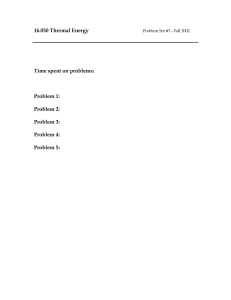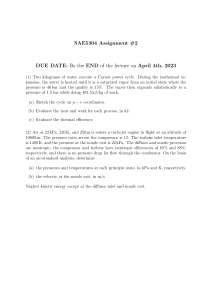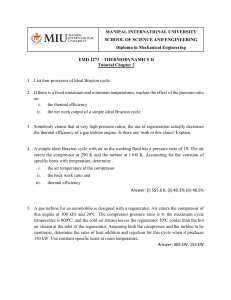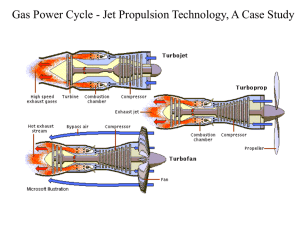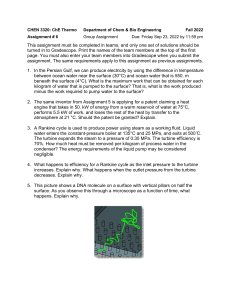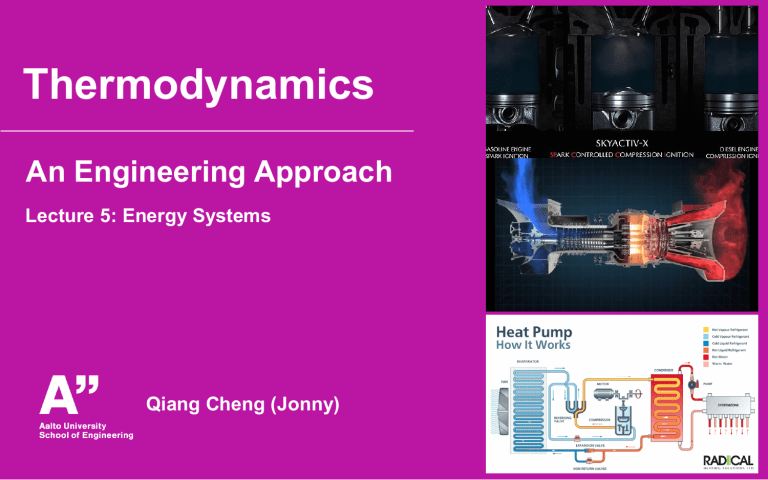
Thermodynamics An Engineering Approach Lecture 5: Energy Systems Qiang Cheng (Jonny) Learning Outcomes When you complete your study of this chapter, you will be able to… Explain the basic principles of vapor power plants. Develop and analyze thermodynamic models of vapor power plants based on the Rankine cycle and its modifications, including Sketching schematic and accompanying P-V and T-s diagrams. Applying mass, energy, and entropy balances for the basic processes. Evaluating property data at principal states in the cycle. Determining power cycle performance, thermal efficiency, net power output, and mass flow rates. Describe the effects of varying key parameters on Rankine cycle performance. Vapor power Systems Vapor power plants Vaporization is accomplished in fossil-fueled plants by heat transfer to water passing through the boiler tubes from hot gases produced in the combustion of the fuel,. This is also seen in plants fueled by biomass, municipal waste (trash), and mixtures of coal and biomass. In nuclear plants, energy required for vaporizing the cycle working fluid originates in a controlled nuclear reaction occurring in a reactor-containment structure. The pressurized- water reactor has two water loops: One loop circulates water through the reactor core and a boiler within the containment structure; this water is kept under pressure so it heats but does not boil. A separate loop carries steam from the boiler to the turbine. Boiling-water reactors (not shown in Fig) have a single loop that boils water flowing through the core and carries steam directly to the turbine. Vapor power plants Solar power plants have receivers for collecting and concentrating solar radiation. A suitable substance, molten salt or oil, flows through the receiver, where it is heated, directed to an interconnecting heat exchanger that replaces the boiler of the fossil- and nuclear-fueled plants, and finally returned to the receiver. The heated molten salt or oil provides energy required to vaporize water flowing in the other stream of the heat exchanger. This steam is provided to the turbine. The geothermal power plant also uses an interconnecting heat exchanger. In this case hot water and steam from deep below Earth’s surface flows on one side of the heat exchanger. A secondary working fluid having a lower boiling point than the water, such as isobutane or another organic substance, vaporizes on the other side of the heat exchanger. The secondary working fluid vapor is provided to the turbine. Vapor power plants Referring to subsystem B of Fig. a again, observe that each unit of mass of working fluid periodically undergoes a thermodynamic cycle as it circulates through the series of interconnected components. This cycle is the Rankine cycle. Important concepts introduced in previous chapters for thermodynamic power cycles generally also apply to the Rankine cycle: 1. The first law of thermodynamics requires that the net work developed by a system undergoing a power cycle must equal the net energy added by heat transfer to the system . 2. The second law of thermodynamics requires that the thermal efficiency of a power cycle must be less than 100% Modeling the Rankine Cycle The Rankine cycle is an idealized thermodynamic cycle describing the process by which certain heat engines, such as steam turbines or reciprocating steam engines, allow mechanical work to be extracted from a fluid as it moves between a heat source and heat sink. Turbine Condenser Pump Boiler Performance Parameters Ideal Rankine Cycle If the working fluid passes through the various components of the simple vapor power cycle without irreversibilities, frictional pressure drops would be absent from the boiler and condenser, and the working fluid would flow through these components at constant pressure. Also, in the absence of irreversibilities and heat transfer with the surroundings, the processes through the turbine and pump would be isentropic. A cycle adhering to these idealizations is the ideal Rankine cycle Process 1–2 Isentropic expansion of the working fluid through the turbine from saturated vapor at state 1 to the condenser pressure. Process 2–3 Heat transfer from the working fluid as it flows at constant pressure through the condenser exiting as saturated liquid at state 3. Process 3–4 Isentropic compression in the pump to state 4 in the compressed liquid region. Process 4–1 Heat transfer to the working fluid as it flows at constant pressure through the boiler to complete the cycle. Temperature–entropy diagram of the ideal Rankine cycle Because the pump is idealized as operating without irreversibilities Principal Irreversibilities and Losses Internal Effects Turbine Pump Temperature–entropy diagram showing the effects of turbine and pump irreversibilities. Improving performance—Superheat, Reheat, and Supercritical As we are not limited to having saturated vapor at the turbine inlet, further energy can be added by heat transfer to the steam, bringing it to a superheated vapor condition at the turbine inlet. This is accomplished in a separate heat exchanger called a superheater. Superheat Reheat A further modification normally employed in vapor power plants is reheat. With reheat, a power plant can take advantage of the increased efficiency that results with higher boiler pressures and yet avoid low-quality steam at the turbine exhaust. Improving performance—Regenerative Vapor power Cycle Let us consider how regeneration can be accomplished using an open feedwater heater, a type of direct-contact heat exchanger in which streams at different temperatures mix to form a stream at an intermediate temperature. Closed Feedwater heaters Regenerative feedwater heating also can be accomplished with closed feedwater heaters. Closed heaters are shell-and-tube-type recuperators in which the feedwater temperature in- creases as the extracted steam condenses on the outside of the tubes carrying the feedwater. Since the two streams do not mix, they can be at different pressures. Multiple Feedwater heaters Gas power Systems Considering Internal Combustion Engines Considering Internal Combustion Engines Air-Standard Otto Cycle Process 1–2: An isentropic compression of the air as the piston moves from bottom dead center to top dead center. Process 2–3: A constant-volume heat transfer to the air from an external source while the piston is at top dead center. This process is intended to represent the ignition of the fuel–air mixture and the subsequent rapid burning. Process 3–4: An isentropic expansion (power stroke). Process 4–1: Completes the cycle by a constant-volume process in which heat is rejected from the air while the piston is at bottom dead center. p–and T–s diagrams of the air-standard Otto cycle. When analyzing air-standard cycles, it is frequently convenient to regard all work and heat transfers as positive quantities and write the energy balance accordingly. Cycle Analysis The net work of the cycle is expressed as the net heat added 𝑄𝑐𝑦𝑐𝑙𝑒 𝑚 = 𝑄23 𝑚 − 𝑄41 𝑚 When air table data are used to conduct an analysis involving an air-standard Otto cycle, the specific internal energy values required by above equation can be obtained from Table A-22 or A-22E as appropriate. The following relationships for the isentropic processes 1–2 and 3–4 = 𝑢3 − 𝑢2 - 𝑢4 − 𝑢1 The thermal efficiency is the ratio of the net work of the cycle to the heat added. where r denotes the compression ratio. where k is the specific heat ratio, k =cp/c. Air-Standard Diesel Cycle Cycle Analysis In the Diesel cycle the heat addition takes place at constant pressure. The heat added in Process 2–3 can be found by applying the closed system energy balance The thermal efficiency is the ratio of the net work of the cycle to the heat added: p–and T–s diagrams of the air-standard Diesel cycle. Air-Standard Diesel Cycle For a given initial temperature T1 and compression ratio r, the temperature at state 2 can be found using the following isentropic relationship and r data: To find T3, note that the ideal gas equation of state reduces with p3 =p2 to give where rc =V3/V2, called the cutoff ratio. Since V4 =V1, the volume ratio for the isentropic process 3–4 can be expressed as The temperature T4, can be determined by interpolation once υr4 is found from the isentropic relationship In a cold air-standard analysis, the appropriate expression for evaluating T2 is provided by Gas turbine power plants Modeling Gas turbine power plants Simple gas turbine. (a) Open to the atmosphere. (b) Closed. Air-Standard Brayton Cycle Assuming the turbine and compressor operates adiabatically and with negligible effects of kinetic and potential energy, the work developed per unit of mass flowing is turbine Compressor The heat added and rejected to the cycle per unit of mass is added Air-standard gas turbine cycle. Rejected The back work ratio for the cycle is Ideal Air-Standard Brayton Cycle Air-standard ideal Brayton cycle. When an ideal Brayton cycle is analyzed on a cold airstandard basis, the specific heats are taken as constant. When air table data are used to conduct an analysis involving the ideal Brayton cycle, the following relationships, apply for the isentropic processes 1–2 and 3–4: where p2/p1 is the compressor pressure ratio. Recall that pr is tabulated versus temperature in Tables A-22. Ideal Air-Standard Brayton Cycle Effect of compressor Pressure Ratio on Performance The increase in thermal efficiency with the pressure ratio across the compressor is also brought out simply by the following development, in which the specific heat cp and, thus, the specific heat ratio k are assumed constant. For constant cp Since T4/T1 =T3/T2 Ideal Brayton cycle thermal efficiency and net work per unit of mass flow versus compressor pressure ratio for k =1.4, a turbine inlet temperature of 1700 K, and a compressor inlet temperature of 300 K. Ideal Brayton cycles with different compressor pressure ratios and the same turbine inlet temperature. Gas turbine–Based Combined Cycles Combined Gas turbine–Vapor power Cycle Combined-cycle district heating plant Integrated Gasification Combined-Cycle power plants Gas turbines for Aircraft propulsion Schematic of a turbojet engine with afterburner. Applications of the Rate Balances to Control Volumes at Steady State Other examples of aircraft engines. (a) Turboprop. (b) Turbofan. (c) Ramjet. Refrigeration Vapor refrigeration Systems The coefficient of performance of any refrigeration cycle is the ratio of the refrigeration effect to the net work input required to achieve that effect. For the Carnot vapor refrigeration cycle shown in left Figure, the coefficient of performance is Carnot vapor refrigeration cycle Analyzing Vapor-Compression refrigeration Systems For a control volume enclosing the refrig- erant side of Vapor-compression refrigeration systems are the most common refrigeration systems in use today. The objective of this section is to introduce some important features of systems systems of this type and to illustrate how they are modeled thermodynamically. the evaporator, the mass and energy rate balances reduce to give the rate of heat transfer per unit mass of refrigerant flowing as Assuming no heat transfer to or from the compressor, the mass and energy rate balances for a control volume enclosing the compressor give For a control volume enclosing the refrigerant side of the condenser, the rate of heat transfer from the refrigerant per unit mass of refrigerant flowing is Selecting refrigerants Environmental Considerations Because of the molecular stability of the CFC and HCFC molecules, their adverse effects are long-lasting. Natural Refrigerants Nonsynthetic, naturally occurring substances also can be used as refrigerants. Called natural refrigerants, they include carbon dioxide, ammonia, and hydrocarbons. Refrigeration with No Refrigerant Needed Alternative cooling technologies aim to achieve a refrigerating effect without use of refrigerants, thereby avoiding adverse effects associated with release of refrigerants to the atmosphere. One such technology is thermoelectric cooling. Heat Pump Heat pump Systems The objective of a heat pump is to maintain the temperature within a dwelling or other building above the temperature of the surroundings or to provide a heat transfer for certain industrial processes that occur at elevated temperatures. • A reversible process is one which can be made to "retrace" its path exactly. • A process is reversible when the successive states of the process are Infinitesimally close to Equilibrium States. i.e. the process is quasi-equilibrium. • With a reversible process it is possible to restore the system to its original state without needing an external agent or changing its surroundings. • Reversible processes are an abstraction that aids the analysis of real processes. • A reversible process is a standard of comparison for an actual system. • Truly reversible thermal processes would require an infinite amount of time for completion. Carnot heat pump Cycle CARNOT'S THEOREM "The efficiency of all reversible engines operating between the same two temperatures is the same, and no irreversible engine operating between these temperatures can have a greater efficiency than this" Nicolas Léonard Sadi Carnot (1796–1832) Carnot Cycle The Carnot cycle is an ideal reversible cyclic process involving the expansion and compression of an ideal gas, which enables us to evaluate the efficiency of an engine utilizing this cycle. At steady state, the rate at which energy is supplied to the warm region by heat transfer is the sum of the energy supplied to the working fluid from the cold region, Qin, and the net rate of work input to the cycle, Wnet. That is, The coefficient of performance of any heat pump cycle is defined as the ratio of the heat- ing effect to the net work required to achieve that effect. Vapor-Compression heat pumps Air-source vapor-compression heat pump system Example of an air-to-air reversing heat pump. Gas refrigeration Systems Brayton refrigeration Cycle The method of analysis of the Brayton refrigeration cycle is similar to that of the Brayton power cycle. Thus, at steady state the work of the compressor and the turbine per unit of mass flow are, respectively, Heat transfer from the cold region to the refrigerant gas circulating through the low-pressure heat exchanger, the refrigeration effect, is The coefficient of performance is the ratio of the refrigeration effect to the net work input: Brayton refrigeration cycle.

